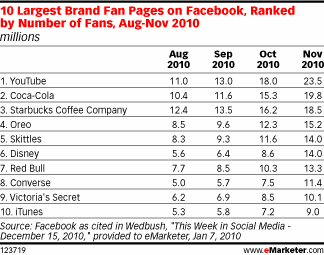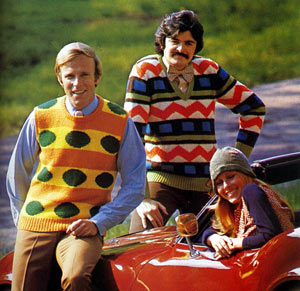 In a study conducted by Cone, 77% of study participants indicated that they want brands to provide incentives online and 28% want to be entertained by brands online. When it comes to connecting with consumers on Facebook, brands that offer incentives and entertainment are leaving the competition behind. You can see some of the companies that are finding success with Facebook pages in the chart from eMarketer shown to the left.
In a study conducted by Cone, 77% of study participants indicated that they want brands to provide incentives online and 28% want to be entertained by brands online. When it comes to connecting with consumers on Facebook, brands that offer incentives and entertainment are leaving the competition behind. You can see some of the companies that are finding success with Facebook pages in the chart from eMarketer shown to the left.
One of the best examples of delivering the type of content a brand’s target audience wants on Facebook is Red Bull, a brand whose Facebook page grew from a couple million fans in early 2010 to over 12 million by the end of that year. The Red Bull Facebook page is targeted directly at the 18-24 year old market with feeds from professional athletes, games, and entertaining features like the Drunkish Dials and Procrastination Station.
Successful brand Facebook pages are not static. They continually offer useful information, entertaining content, and conversations that add value to consumers’ lives. As eMarketer reports, Coca-Cola held a year-long social media campaign targeted at its Facebook page fans. In an effort to keep the Coca-Cola Facebook page an active place for fans to find the useful and valuable information they want and need, Coca-Cola’s Expedition 206 campaign used brand ambassadors to constantly update the Coca-Cola Facebook page with fresh content. As a result, the Coca-Cola Facebook page more than doubled in 2010 to nearly 20 million fans in December 2010.
eMarketer also reports that by adding an interactive game to its Facebook page, Oreo doubled the number of fans its Facebook page had in 2010 as well. In an effort to better integrate social media marketing efforts with traditional marketing initiatives, Oreo added an in-person event element to the campaign in late 2010.
The key to Facebook page success for brands is to remember that a Facebook page isn’t meant to be a place to publish company news. It’s a place that should be interactive and fun or there is no real reason for people to visit. Brands like Red Bull and Coca-Cola have developed Facebook pages that can be benchmarked and improved upon by other brands.
In fact, it’s probably safe to say that the Facebook pages for brands that exist in early 2011 will look very different in early 2012 as more and more brands understand what works in Facebook marketing. As the Cone study revealed, consumers want incentives and entertainment from brands in the new media space. Now, it’s up to companies to create the types of branded experiences on the social Web that consumers are asking for.


 Facebook is getting more buzz
Facebook is getting more buzz
 New research from
New research from